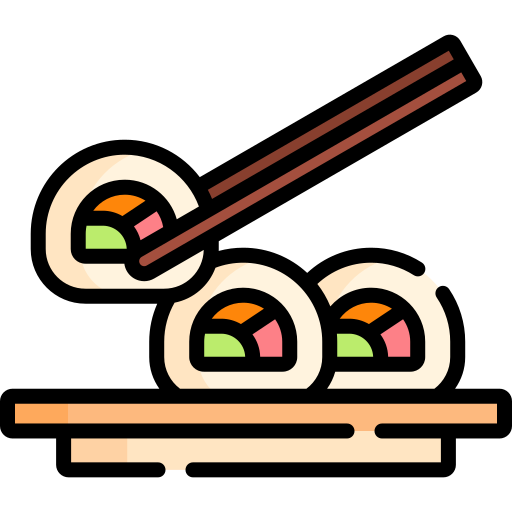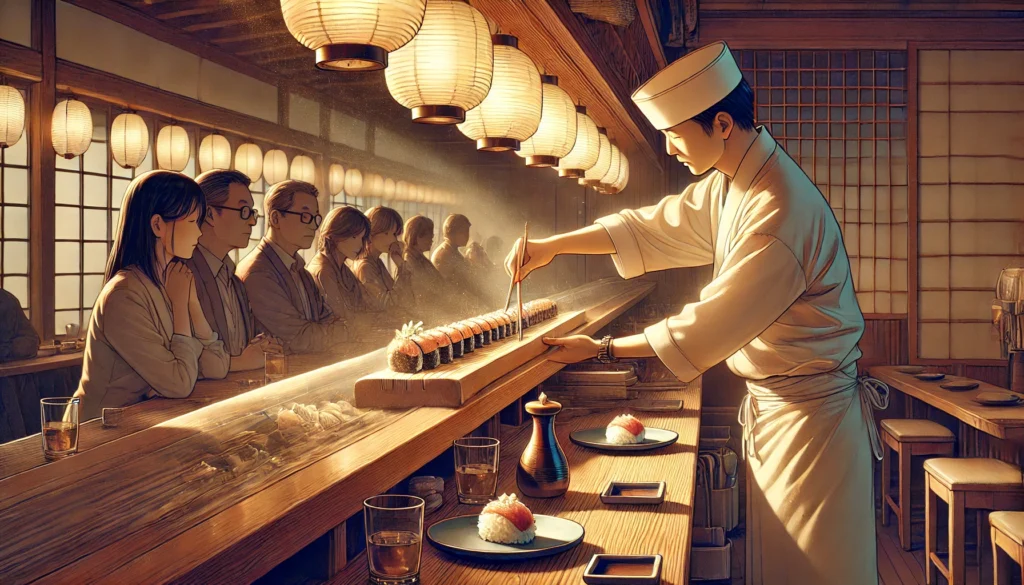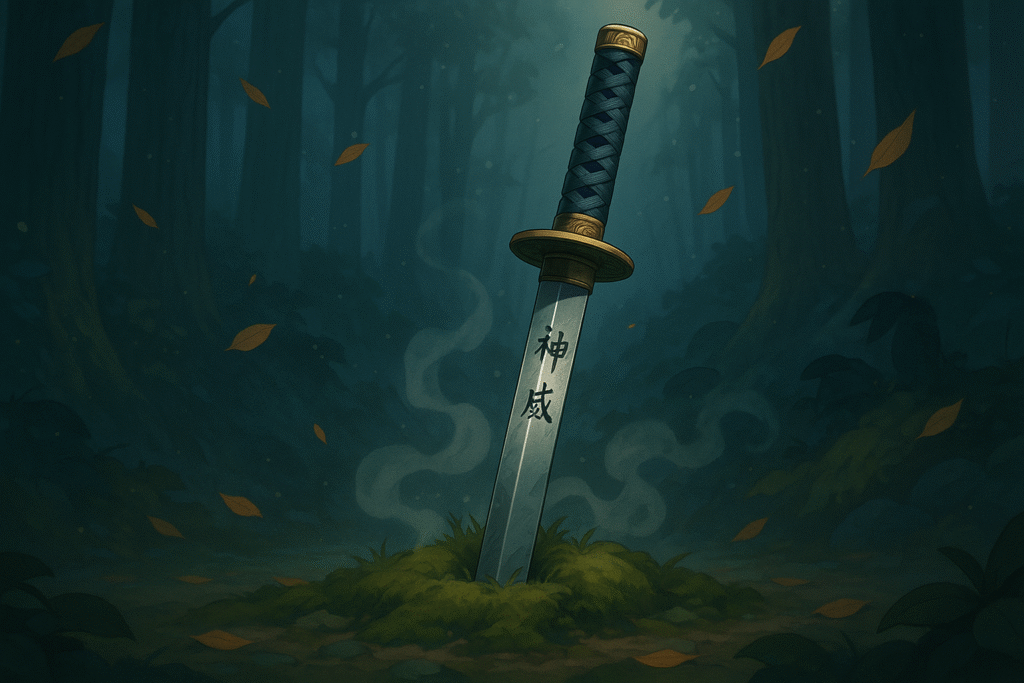There’s something almost magical about enjoying authentic sushi in Tokyo, where the art of preparing these delicate morsels has been perfected over centuries. As you sit at a counter watching master chefs transform fresh catches into glistening pieces of nigiri, you’ll understand why Tokyo is considered the global capital of sushi. From legendary market stalls to exclusive counters where reservations are like gold dust, this guide will take you through the very best sushi experiences the Japanese capital has to offer.
Want to explore Japan’s culture?
Discover Japan’s rich culture, traditions, and hidden gems with our expertly crafted guides. Get insider tips on travel, food, and history. All for free!
Why Sushi in Tokyo Is Unlike Anywhere Else in the World
The magic of sushi in Tokyo begins with its proximity to one of the world’s greatest seafood markets. When you bite into a piece of otoro (fatty tuna) that melts in your mouth or savor the subtle sweetness of fresh uni (sea urchin), you’re experiencing the pinnacle of freshness and quality.
What truly sets sushi in Tokyo apart, however, is the dedication to craftsmanship. Tokyo’s top sushi chefs train for decades, perfecting rice preparation, fish aging techniques, and precise knife skills. Many apprentices spend years just learning to make proper sushi rice before they’re allowed to touch fish!
As one regular Tokyo visitor noted: “Any average high-end sushiya in Tokyo would likely beat out 99% of the ones in the US.” This isn’t hyperbole—it’s the reality of dining in a city where sushi isn’t just food, but an art form worthy of lifelong dedication.
Navigating Tokyo’s Sushi Scene: From Luxury to Value
High-End Omakase Experiences
For the ultimate sushi in Tokyo experience, nothing compares to an omakase meal at a top-tier restaurant. As we’ve explained in our guide to omakase dining, this “chef’s choice” approach puts you in the hands of a master who will craft a personalized sequence of nigiri based on the day’s best catches and seasonal specialties.
Sushi Arai: Tuna Heaven
Located in a discreet building in Ginza, Sushi Arai has earned a reputation for serving some of the most memorable tuna in Tokyo. The toro (fatty tuna) here is nothing short of transformative—it practically dissolves on your tongue, leaving behind a rich, buttery flavor that lingers pleasantly.
What makes this establishment special is their occasional serving of seared tuna cheek, a rare delicacy that regular patrons eagerly anticipate. While reservations can be made online 2-3 months in advance, scoring a seat at the main counter with Chef Arai himself requires connections or extraordinary timing.
Sushisho Masa: Variety Champion
For those who value diversity in their sushi experience, Sushisho Masa delivers an impressive parade of nearly 50 different items during their omakase. This Roppongi establishment alternates between nigiri and small cooked dishes, creating a rhythm that keeps your palate engaged throughout the extended dining journey.
The energetic, younger team creates a lively atmosphere and their decent English skills make this spot particularly foreigner-friendly. Despite the extraordinary variety, every piece maintains exceptional quality—a testament to the kitchen’s expertise.
Umi: Home of Perfect Anago
Nestled in Aoyama, Umi serves what many consider the pinnacle of anago (sea eel) in Tokyo. Unlike the sweet, sauce-heavy unagi that many Westerners are familiar with, Umi’s anago is lightly torched to enhance its natural oils, creating a delicate crisp exterior while maintaining a melt-in-your-mouth interior.
Every piece at Umi glistens under the counter lights, a visual indicator of the chef’s precision in preparation. While online reservations are available, you’ll need to book at least a month in advance to secure a spot at this renowned establishment.
Mid-Range Excellence: Tokami
Not quite ready to splurge on the highest-end sushi in Tokyo? Sushi Tokami offers an excellent compromise. Once ranked in Tabelog’s top ten sushi restaurants in Tokyo, this establishment delivers high-quality nigiri in a slightly more accessible package.
While nothing stands out as particularly revolutionary compared to Tokyo’s most exclusive counters, every piece is executed with precision and beauty. Their lunch menu offers especially good value for those looking to experience quality sushi without breaking the bank.
The restaurant is also relatively easier to book than some of its competitors, making it an excellent choice for visitors who didn’t plan months ahead.

Market Champions: Budget-Friendly Excellence
Sushi Dai: Worth the Wait?
No discussion of sushi in Tokyo would be complete without mentioning Sushi Dai, the legendary market sushiya that has drawn predawn queues for decades. Now located in Toyosu Market (having moved from the original Tsukiji location), this humble establishment serves what many consider the best sushi under $100 in Tokyo—with most meals costing closer to $50.
While the presentation may lack the refinement of high-end establishments, the quality of fish is remarkable for the price point. The restaurant has expanded from its original thirteen seats to twenty, potentially reducing the infamous wait times that once had visitors lining up at 4am for a 7am opening.
Daiwa Sushi: The Savvy Alternative
For those who value sleep over bragging rights, Daiwa Sushi offers a compelling alternative to Sushi Dai. Often considered the second-best market sushiya, Daiwa historically had shorter queues due to its larger seating capacity.
The quality difference between the two is minimal—certainly not proportional to the difference in wait times. For visitors to Toyosu Market seeking excellent sushi without sacrificing hours in line, Daiwa represents one of Tokyo’s best value propositions.
Love Japan? Stay in the Loop!
Get the best of Japan straight to your inbox: language, culture & travel insights!
Tips for First-Time Visitors to Tokyo Sushi Counters
When enjoying sushi in Tokyo, understanding basic etiquette enhances both your experience and the chef’s ability to serve you effectively:
- Trust the chef: Resist the urge to dip premium nigiri in soy sauce unless specifically instructed. Most pieces are already perfectly seasoned.
- Eat each piece in one bite: Nigiri is designed as a complete, balanced bite with precisely the right ratio of fish to rice.
- Use your hands: Traditional nigiri is finger food! Your hands maintain the perfect temperature and structure of the piece.
- Basic Japanese helps: Even learning a few essential Japanese phrases shows respect for the culture and can significantly enhance your dining experience. Our guide to “100+ Essential Japanese Phrases” is perfect for preparing for your sushi adventure.
- Reservations are critical: For high-end sushi in Tokyo, book months in advance or work with your hotel concierge.
If you’re learning to count in Japanese to understand the chefs, our “Counting to 100 in Japanese” guide covers all the counters you’ll need, including the special counters used for pieces of sushi!
Beyond Sushi: Understanding Japanese Dining Culture
To fully appreciate sushi in Tokyo, it helps to understand the broader context of Japanese cuisine. Many visitors find our Japanese Food: Ultimate Guide to Traditional and Modern Cuisine provides valuable insights that enhance every meal during their trip.
For those intrigued by other dramatic dining experiences, our guide on What Is Teppanyaki? explores another iconic Japanese cooking style that offers a completely different—but equally memorable—culinary adventure.
The Best Season to Experience Sushi in Tokyo
While sushi in Tokyo is exceptional year-round, many connoisseurs believe late autumn to early winter offers the most stellar lineup of seasonal specialties, including fatty fish at their prime. Spring brings its own bounty with delicacies like sayori (needlefish) and hotaru ika (firefly squid).
Reading a Japanese menu can be challenging for visitors, but our Hiragana & Katakana Cheat Sheet can help you decipher the basics, while the JLPT N5 Kanji Cheat Sheet covers many of the characters commonly found in restaurant settings.

Frequently Asked Questions About Sushi in Tokyo
What is the best sushi restaurant in Tokyo?
The best sushi restaurant in Tokyo depends on personal preference, but Sushi Arai, Sushisho Masa, and Umi consistently rank among the top establishments offering exceptional omakase experiences.
How much does good sushi cost in Tokyo?
Good sushi in Tokyo ranges from $50 at market stalls like Sushi Dai to $300+ at exclusive high-end establishments. Mid-range excellent options typically cost $100-200 per person.
Do I need to speak Japanese to enjoy sushi in Tokyo?
No, you don’t need to speak Japanese to enjoy sushi in Tokyo. Many high-end establishments have English-speaking staff, though learning basic phrases enhances the experience.
How far in advance should I book sushi restaurants in Tokyo?
Book high-end sushi restaurants in Tokyo 2-3 months in advance. The most exclusive establishments may require booking through a hotel concierge or specialized reservation service.
Are there good budget sushi options in Tokyo?
Yes, Tokyo has excellent budget sushi options, particularly in the Toyosu Market where establishments like Sushi Dai and Daiwa offer exceptional quality at much lower prices than high-end counters.
Ready to experience the incredible world of sushi in Tokyo? Download our free Japanese travel guides to prepare for your culinary adventure! From language basics to cultural insights, we’ve got you covered.
Join Fellow Japan Enthousiasts!
Ask questions, get study tips, and take part in weekly challenges. Join a community of motivated learners exploring both the language and culture of Japan!




